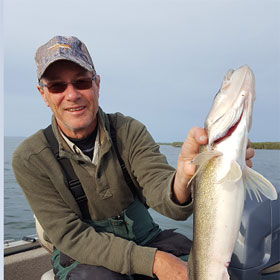Trolling crankbaits an easy, effective way to fish in Minnesota
By C.B. Bylander
Oct 31, 2019
Trolling crankbaits is an easy and effective way to fish, including fishing for walleye during autumn in Minnesota. It’s a great way to cover a lot of water in a fairly short time.
One of the things I enjoy while visiting my cabin in northern Minnesota is watching anglers troll crankbaits past my dock.
They seem at peace.
They seem at peace because they aren’t constantly casting, reeling, tossing anchors, hoisting anchors, deploying drift socks or otherwise messing with this or that.
Instead, they mostly sit. And they enjoy the boat ride.
There is something to be said for this, and what’s to be said is “simplicity.” Trolling crankbaits for walleyes and other species is an easy and effective angling technique in which you can cover a lot of water in a relatively short time. It is also a great way to fish with fidgety kids or older adults, who quite often, are simply looking forward to a relaxing day on the water.
So how do you troll crankbaits?
Well, it can be as easy or complex as you like. Complex means buying special planer boards, lead core fishing line, reels that measure how much line you let out and more.
Simple means buying a few crankbaits, pitching them behind the boat with your spinning rod then trolling slowly, typically about 2 miles per hour. If this type of fishing appeals to you here are some things to consider:
What to buy
A crankbait is a hard plastic lure that looks like some type of forge fish. It is designed to wobble in a natural way when pulled through the water. The lure’s vibration and life-like appearance trigger strikes. Crankbaits come in many different colors, styles and shapes. You will want to purchase lures that mimic the dominant forage species in the waters you fish. Your local bait shop can help you with this as you are trying to “match the hatch” so to speak. Typically, Midwest anglers fish fairly small crankbaits in spring and early summer when young-of-the-year forage fish are small. As the year progresses many anglers switch to larger lures. Many popular walleye crankbaits are long and slender. These lures replicate certain minnow species. Many others have chunkier bodies that mimic shad, perch or other dominant prey species. Crankbaits come in floating and sinking options. Directions on how to use them are typically printed on the box in which they came. Also, some crankbaits re designed to wobble a lot and others less so. Again, check with your local sports shop for the best options in your area.
Where to fish
Simple trolling typically means fishing in water 15 feet deep or less. Basically, this means shorelines, the inside and outside edges of weedbeds, over rocky points and submerged islands and the saddles between deeper holes. Trolling over shallow sand flats is a good option in spring when walleye feed in these warm waters.
Things to know
Watch your rod tip while trolling. The way it wiggles indicates if the boat speed is about right. If your rod tip isn’t wiggling at all it likely means you have weeds on your lure. Depending on the lure you choose you may have to let out 50, 100 or even 150 feet of line. The goal is have your lure near the bottom, even ticking the bottom from time to time. When a fish hits you don’t have to make a powerful sweeping hook set because with these types of lures the fish largely hook themselves. Enjoy!









